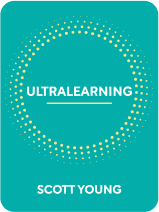

This article is an excerpt from the Shortform book guide to "Ultralearning" by Scott Young. Shortform has the world's best summaries and analyses of books you should be reading.
Like this article? Sign up for a free trial here .
Do you want to create an ultralearning project? What do you need to do to design your first self-directed study plan and put it into motion?
The five steps for creating ultralearning projects are 1) research, 2) create a schedule, 3) actualize your plan, 4) analyze your results, and 5) determine your post-project plan. Follow these steps to achieve mastery over a subject.
In this article, we’ll break down the five steps to creating your first ultralearning project.
Setting Up Your First Ultralearning Project
Ultralearning is a strategic approach to learning that is intensive and self-directed.
- Intensive learning is learning as deeply as possible at an accelerated pace (in contrast to leisure learning, done at a relaxed pace).
- A strategy is an approach to solving a problem or achieving a goal.
- A self-directed learning strategy is a method for achieving a learning goal that works best for you.
Here is how to create your first ultralearning project in five simple steps.
Step #1: Research
With ultralearning projects, your first step will always be to conduct metalearning research. This will save you time and boost efficiency by allowing you to create the learning structure most appropriate for your learning goals. By the time you finish this step, you should have clarity on five components.
Component #1: Learning Goals
First, determine what you want to learn. Is your motivation instrumental? Perhaps you wish to start a business, or develop skills to boost your advantage for a promotion at work. Or is your motivation intrinsic? Perhaps you want to learn a new language or how to play the guitar.
Select a simple learning goal for your first project. You can always expand upon it, but be realistic initially.
Component #2: Resource List
Next, create a list of core materials to support your learning. This can include podcasts, books, video content, YouTube “how-to” videos, friends, colleagues, coaches, and so on. Additionally, use this research as an opportunity to figure out where you intend to start. For example, let’s say you want to learn Spanish. Your plan might be to learn Spanish using Rosetta Stone software. Make sure you have all your materials before you get started.
Component #3: Learning Benchmarks
Another critical component is knowing what successful learning looks like for your specific goals. Take this opportunity to research what others may have used to achieve the same or similar goals. You don’t need to replicate what worked for others, but the information serves as a guideline, both for common pitfalls as well as things that work.
Component #4: Practice Activities
Brainstorm how you will put what you are learning into practice. It is ideal that this practice be direct and begun as quickly as possible. If you realize at this stage that you’re not able to practice directly, come up with ideas for activities that will strengthen whatever components will be necessary to master the skill or topic.
Component #5: Alternative Resources and Activities
This is where you identify practices and materials to use as a backup if your core tools are no longer useful, or as a way to build on existing resources.
Step #2: Create Your Schedule
A time investment is necessary to be successful in your learning goals, and while an excessive routine is not required for proficiency, different learning goals will vary in their time requirements. Determine how much time you’re willing to spend now so that you don’t run into pressure or frustration down the line. By setting a schedule in advance, you support yourself in two ways.
- You solidify in your subconscious that you are committed to the project. This will automatically set you up to prioritize it.
- You bolster your motivation in the face of tempting distractions because you have a plan to stick to.
To do this step successfully, make three decisions.
- How much time are you willing to devote to the project?
- What do you want your learning schedule to look like?
- What is your overall time benchmark for the project?
The best schedules are consistent because that steadiness helps you to develop healthy study patterns and consequently save energy in the long-term. If your schedule needs to be flexible, it’s best to learn in shorter increments at spaced out intervals. In some cases, you might prefer long stretches of study (for example, if you’re writing and need the time to get into a good flow).
It’s often easier to dedicate energy towards short-term rather than long-term commitments. So, even if you have a large learning goal, split it into short-term goals that support the long-term benchmark. If you have a longer-term project, do a test run of it for a week. This gives you an opportunity to spot any flaws or impediments and make modifications before you officially begin the project.
Once you determine all of this, immediately document it in your calendar or planner. Doing this detailed scheduling in advance will support you to notice possible obstacles (like other time commitments), and keeps the commitment to the project at the forefront of your mind. If you have difficulty demonstrating your commitment at this stage, it’s a sign you’re not mentally prepared to start.
Step #3: Actualize Your Plan
This is when you put your project into action. Be mindful throughout the process of whether or not your actions are aligned with ultralearning principles and your overall learning goal.
One strategy is to construct questions for yourself for each principle to check your progress.
- Metalearning: Have I completed enough research to determine the best ways to learn this skill or topic? Is there anyone I can get new insights from?
- Focus: Am I able to concentrate during my learning sessions? Am I working in an optimal environment for focus?
- Directness: Am I practicing my skill in an environment similar to the real one? How else can I practice directly?
- Drill: Do I feel overwhelmed by the components of what I’m learning? How can I break down more complex concepts?
- Retrieval: How often do I check my notes when practicing recall? Am I easily able to recall old learned information or only recently learned information?
- Feedback: What is the status of my learning progress? How do I know what to improve? Is there any feedback I’m considering that I shouldn’t?
- Retention: Am I using deliberate spacing to encourage long-term retention? Am I practicing overlearning?
- Intuition: How deeply do I understand what I’m learning? Can I write a fictional story or short essay about what I’m learning? Can I easily explain it to someone else?
- Experimentation: Am I stagnant in my learning approach? Do I need to explore new avenues of learning? How can I go beyond proficiency to achieve personal mastery?
Make modifications wherever necessary and possible.
Step #4: Analyze Your Results
Regardless of your success, it is always valuable to analyze your results. For successful projects, repeat the things that worked, and for weak projects, identify where and how to improve. Beyond just mastering a skill or subject, the overall goal of ultralearning is to become a deeper, more effective, and efficient learner.
Step #5: Determine Your Post-Project Plan
Much of what we learn decays with time, so determine your plan for retention right after you reach the learning goal, using three core strategies.
#1: Maintenance
This approach involves practicing what you’ve learned just enough to maintain the proficiency level you achieved by the end of your project. One way of doing this is to get into the routine of practicing regularly. This doesn’t have to be rigorous, but consistency is key. Another way is to figure out how to incorporate what you’ve learned into your day-to-day life. This is less predictable or consistent, but it ensures that what you’ve learned continues to be usable.
The longer you maintain your knowledge of something, the more likely it is to be retained. You can eventually reduce the frequency and intensity of your practice without worrying about losing a majority of the information or skill.
#2: Relearning
If you don’t want to do regular maintenance, come up with a plan for relearning the skill or topic when you need to. The first go-around when learning something is usually harder than relearning. The information, while not easily accessed, is still accessible with proper recall cues. Relearn by taking a class or designing a series of activities to relearn on your own.
#3: Mastery
You may not be satisfied with proficiency and will want to deepen your learning further. If you practice regularly at a less intense pace or immediately begin a new learning project that supplements the original learning goals, you will put yourself on the road to mastery.
Mastery is generally an incremental path, and once you’ve reached proficiency, you can proceed with further study at a slower pace. However, if you’re learning something particularly challenging, you can also reach mastery through the more intensive ultralearning pace.

———End of Preview———
Like what you just read? Read the rest of the world's best book summary and analysis of Scott Young's "Ultralearning" at Shortform .
Here's what you'll find in our full Ultralearning summary :
- How a formal education doesn’t open the doors it once could
- The 9 core principles that can help you master any skill
- How to create a self-directed learning project to help you advance in your field






